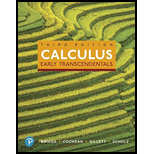
Explain why or why not Determine whether the following statements are true and give an explanation or counterexample.
a. Assuming g is integrable and a, b, c, and d are constants,
b. The spherical equation φ = π/2, the cylindrical equation z = 0, and the rectangular equation z = 0 all describe the same set of points.
c. Changing the order of
d. The transformation T: x = v, y = −u maps a square in the uv-plane to a triangle in the xy-plane.
a.
Whether the statement “Assuming g is integrable and a, b, c and d are constants,
Answer to Problem 1RE
The statement is false.
Explanation of Solution
Theorem used:
Fubini’s Theorem:
Let f be continuous on the rectangular region
The double integral of f over R may be evaluated by either of two iterated integrals:
Description:
The integrable function is g and the constants are a, b, c and d.
Use the Fubini’s theorem to prove or disprove the given statement.
The integral expression
Consider the example of the volume of a solid bounded by the surface
Simplify the left hand side of the equation as follows.
On further simplification,
That is,
Simplify the Right hand side of the equation as follows.
On further simplification,
From the equations (1) and (2), the evaluated values are not the same.
Hence, the statement is false.
b.
Whether the statement “The spherical equation
Answer to Problem 1RE
The statement is true.
Explanation of Solution
The set of sphere for
Here,
The set of cylinder for
Thereby the set
Thus, the spherical equation
Hence, the statement is true.
c.
Whether the statement “Changing the order of integration in
Answer to Problem 1RE
The statement is false.
Explanation of Solution
Theorem used:
Let f be continuous over the region,
where g, h, G and H are continuous functions. Then f is integrable over D and the triple integral is evaluated as the iterated integral:
Description:
Consider the example,
Use the above theorem to change the order of integration in the above example.
It is observed that the change in order of integration does not alter the integrand.
Hence, the statement is false.
d.
Whether the statement “The transformation
Answer to Problem 1RE
The statement is false.
Explanation of Solution
The given transformations is
Take the image of S in the uv-plane, where
The uv-plane is bounded by the vertices
From
That is,
Substitute
Therefore, xy-plane traces out the segment from
From
That is,
Substitute
Therefore, xy-plane traces out the segment from
From
That is,
Substitute
Therefore, xy-plane traces out the segment from
From
That is,
Substitute
Therefore, xy-plane traces out the segment from
Thus, the image of region in xy-plane is a square with vertices
Hence, it does not maps into a triangle and thereby the statement is false.
Want to see more full solutions like this?
Chapter 16 Solutions
Calculus: Early Transcendentals and MyLab Math with Pearson eText -- Title-Specific Access Card Package (3rd Edition) (Briggs, Cochran, Gillett & Schulz, Calculus Series)
Additional Math Textbook Solutions
Elementary Statistics: Picturing the World (7th Edition)
Elementary Statistics (13th Edition)
Algebra and Trigonometry (6th Edition)
A Problem Solving Approach To Mathematics For Elementary School Teachers (13th Edition)
Calculus for Business, Economics, Life Sciences, and Social Sciences (14th Edition)
- 2. Find a matrix A with the following qualities a. A is 3 x 3. b. The matrix A is not lower triangular and is not upper triangular. c. At least one value in each row is not a 1, 2,-1, -2, or 0 d. A is invertible.arrow_forwardFind the exact area inside r=2sin(2\theta ) and outside r=\sqrt(3)arrow_forwardA 20 foot ladder rests on level ground; its head (top) is against a vertical wall. The bottom of the ladder begins by being 12 feet from the wall but begins moving away at the rate of 0.1 feet per second. At what rate is the top of the ladder slipping down the wall? You may use a calculator.arrow_forward
- Explain the key points and reasons for the establishment of 12.3.2(integral Test)arrow_forwardUse 12.4.2 to determine whether the infinite series on the right side of equation 12.6.5, 12.6.6 and 12.6.7 converges for every real number x.arrow_forwarduse Cauchy Mean-Value Theorem to derive Corollary 12.6.2, and then derive 12.6.3arrow_forward
- Algebra & Trigonometry with Analytic GeometryAlgebraISBN:9781133382119Author:SwokowskiPublisher:Cengage
 Holt Mcdougal Larson Pre-algebra: Student Edition...AlgebraISBN:9780547587776Author:HOLT MCDOUGALPublisher:HOLT MCDOUGAL
Holt Mcdougal Larson Pre-algebra: Student Edition...AlgebraISBN:9780547587776Author:HOLT MCDOUGALPublisher:HOLT MCDOUGAL Elements Of Modern AlgebraAlgebraISBN:9781285463230Author:Gilbert, Linda, JimmiePublisher:Cengage Learning,
Elements Of Modern AlgebraAlgebraISBN:9781285463230Author:Gilbert, Linda, JimmiePublisher:Cengage Learning,  Linear Algebra: A Modern IntroductionAlgebraISBN:9781285463247Author:David PoolePublisher:Cengage Learning
Linear Algebra: A Modern IntroductionAlgebraISBN:9781285463247Author:David PoolePublisher:Cengage Learning Elementary Linear Algebra (MindTap Course List)AlgebraISBN:9781305658004Author:Ron LarsonPublisher:Cengage Learning
Elementary Linear Algebra (MindTap Course List)AlgebraISBN:9781305658004Author:Ron LarsonPublisher:Cengage Learning Elementary Geometry for College StudentsGeometryISBN:9781285195698Author:Daniel C. Alexander, Geralyn M. KoeberleinPublisher:Cengage Learning
Elementary Geometry for College StudentsGeometryISBN:9781285195698Author:Daniel C. Alexander, Geralyn M. KoeberleinPublisher:Cengage Learning





